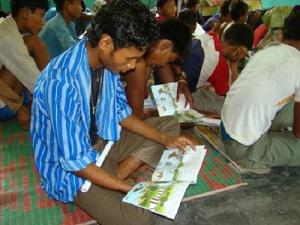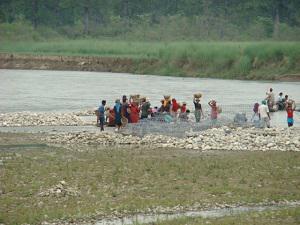Dipesh Joshi
Other projects
31 Jan 2011
Assessing the Status and Distribution of Top Predators in Lowland Karnali River for Enhanced Conservation and Management of the Aquatic Ecosystem
The major objectives of the project are:
(i) assessment of status, distribution and threats facing the smooth-coated Indian otter and
(ii) aquatic biodiversity conservation awareness focussing on major species like Ganges river dolphins, crocodiles and gharials outside the protected areas in Karnali River.

A student reads the booklet on Otters and freshwater ecosystem.
Major threats to Asian otter and other large freshwater animal population are loss of wetland habitats due to construction of large-scale hydroelectric projects, reclamation of wetlands for settlements and agriculture, reduction in prey biomass, poaching and contamination of waterways by pesticides. Inadequate rural development efforts around South-east Asia have exerted an additional pressure on wildlife and biodiversity by increasing the dependency of the rural poor on natural resources. Ultimately, most of the wetlands and waterways have a decreasing prey base for sustaining otter populations. This also implies for endangered species like Ganges River dolphins and gharials inhibiting the same ecosystem.

The study area is of immense importance to aquatic biodiversity as it lies between two large, protected areas on the Indian and Nepali frontier. Aquatic animals are protected both upstream and downstream of this section of the river but face threats from anthropogenic impacts in this area. Thus, it is of utmost importance to study the status, distribution and conservation threats to otters, one of the least studied mammals in this area for long conservation planning. Surveys will be conducted following standard methods to assess the status and distribution of the animal.
At the same time, the project also addresses other major aquatic species like Ganges River dolphins, gharials and crocodiles in the area. Awareness is a major component of the project. This component will encompass biodiversity and conservation aspects of the freshwater ecosystem to raise awareness. This objective of the project will be achieved through local consultations, group discussions and wide involvement of students in the area. The area is inhibited by indigenous tharu and sonaha communities who traditionally have a high dependency on the aquatic ecosystem for subsistence and livelihood. These communities along with the school children are the target groups of awareness component of the project. Awareness and information materials such as posters, postcards and leaflets will be published and distributed among the inhabitants of the area.